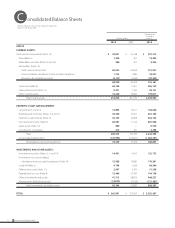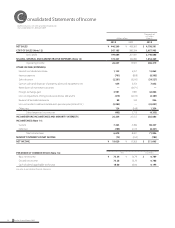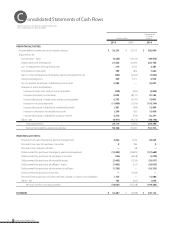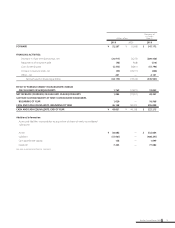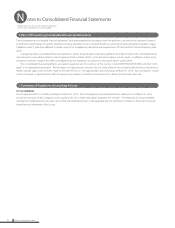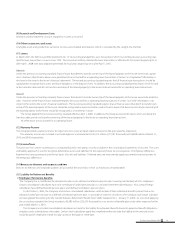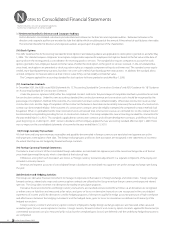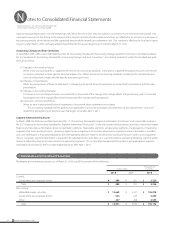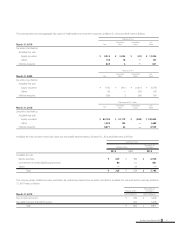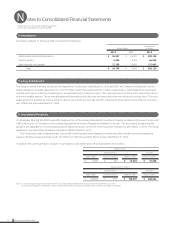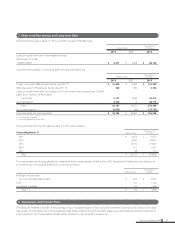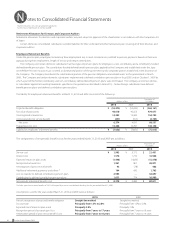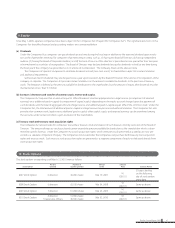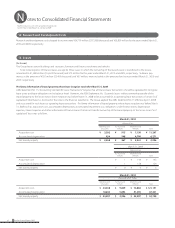Brother International 2010 Annual Report Download - page 26
Download and view the complete annual report
Please find page 26 of the 2010 Brother International annual report below. You can navigate through the pages in the report by either clicking on the pages listed below, or by using the keyword search tool below to find specific information within the annual report.
Notes to Consolidated Financial Statements
Brother Industries, Ltd. and Consolidated Subsidiaries
For the Years ended March 31, 2010 and 2009
(ii) Retirement Benefits for Directors and Corporate Auditors
Certain domestic consolidated subsidiaries provide retirement allowances for directors and corporate auditors. Retirement allowances for
directors and corporate auditors are recorded to state the liability which would be paid at the amount if they retired at each balance sheet date.
The retirement benefits for directors and corporate auditors are paid upon the approval of the shareholders.
(16) Stock Options
The ASBJ Statement No. 8, “Accounting Standard for Stock Options” and related guidance are applicable to stock options granted on and after May
1, 2006. This standard requires companies to recognize compensation expense for employee stock options based on the fair value at the date of
grant and over the vesting period as consideration for receiving goods or services. The standard also requires companies to account for stock
options granted to non-employees based on the fair value of either the stock option or the goods or services received. In the consolidated bal-
ance sheet, stock options are presented as stock acquisition rights as a separate component of equity until exercised. The standard covers equity-
settled, share-based payment transactions, but does not cover cash-settled, share-based payment transactions. In addition, the standard allows
unlisted companies to measure options at their intrinsic value if they cannot reliably estimate fair value.
The Company applied this accounting standard for stock options to those granted on and after May 1, 2006.
(17) Construction Contracts
In December 2007, the ASBJ issued ASBJ Statement No. 15, “Accounting Standard for Construction Contracts” and ASBJ Guidance No. 18, “Guidance
on Accounting Standard for Construction Contracts.”
Under the previous Japanese GAAP, either the completed-contract method or the percentage-of-completion method is permitted to account
for construction contracts. Under this new accounting standard, the construction revenue and construction costs should be recognized by the
percentage-of-completion method, if the outcome of a construction contract can be estimated reliably. When total construction revenue, total
construction costs and the stage of completion of the contract at the balance sheet date can be reliably measured, the outcome of a construction
contract can be estimated reliably. If the outcome of a construction contract cannot be reliably estimated, the completed-contract method shall
be applied. When it is probable that the total construction costs will exceed total construction revenue, an estimated loss on the contract should
be immediately recognized by providing for loss on construction contracts. The Group adopted the new accounting standard for construction for
the year ended March 31, 2010. This standard is applicable to construction contracts and software development contracts, and effective for fiscal
years beginning on or after April 1, 2009. Certain subsidiaries of the Company applied the new accounting standard effective April 1, 2009. There
was no impact on the consolidated statements of income for the year ended March 31, 2010.
(18) Foreign Currency Transactions
All short-term and long-term monetary receivables and payables denominated in foreign currencies are translated into Japanese yen at the
exchange rates at the balance sheet date. The foreign exchange gains and losses from translation are recognized in the statements of income to
the extent that they are not hedged by forward exchange contracts.
(19) Foreign Currency Financial Statements
The balance sheet accounts of the consolidated foreign subsidiaries are translated into Japanese yen at the current exchange rate as of the bal-
ance sheet date except for equity, which is translated at the historical rate.
Differences arising from such translation are shown as “Foreign currency translation adjustments” in a separate component of the equity and
included in minority interests.
Revenue and expense accounts of consolidated foreign subsidiaries are translated into Japanese yen at the average exchange rate during
the year.
(20) Derivative and Hedging Activities
The Group uses derivative financial instruments to manage its exposures to fluctuations in foreign exchange and interest rates. Foreign exchange
forward contracts, interest rate swaps and currency option contracts are utilized by the Group to reduce foreign currency exchange and interest
rate risks. The Group does not enter into derivatives for trading or speculative purposes.
Derivative financial instruments and foreign currency transactions are classified and accounted for as follows: a) all derivatives are recognized
as either assets or liabilities and measured at fair value, and gains or losses on derivative transactions are recognized in the consolidated
statements of income and b) for derivatives used for hedging purposes, if derivatives qualify for hedge accounting because of high correlation
and effectiveness between the hedging instruments and the hedged items, gains or losses on derivatives are deferred until maturity of the
hedged transactions.
Foreign currency contracts and currency option contracts employed to hedge foreign exchange exposures are measured at fair value and
unrealized gains (losses) are recognized in income. Foreign currency forward contracts and currency option contracts applied for forecasted (or
committed) transactions are also measured at fair value, but the unrealized gains (losses) are deferred until the underlying hedged transactions
are completed.
24 Brother Annual Report 2010


